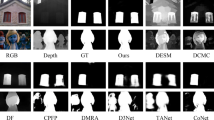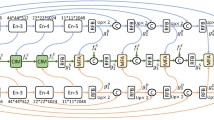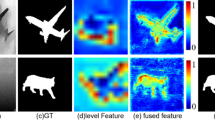Abstract
In this paper we aim to address the problem of saliency detection on RGB-D image pairs based on a multi-stream late fusion network. With the prevalence of RGB-D sensors, leveraging additional depth information to facilitate saliency detection task has drawn increasing attention. However, the key challenge that how to fuse RGB data and depth data in an optimum manner is still under-studied. Conventional wisdom simply regards depth information as an undifferentiated channel and models RGB-D saliency detection by using existing RGB saliency detection models directly. However, this paradigm is incapable of capturing specific representations in depth modality and also powerless in fusing multi-modal information. In this paper, we address this problem by proposing a simple yet principled late fusion strategy carried out in conjunction with convolutional neural networks (CNNs). The proposed network is able to learn discriminant representations and explore the complementarity between RGB and depth modalities. Comprehensive experiments on two public datasets witness the benefits of the proposed RGB-D saliency detection network.
Access this chapter
Tax calculation will be finalised at checkout
Purchases are for personal use only
Similar content being viewed by others
References
Cheng, M., Mitra, N.J., Huang, X., Torr, P.H., Hu, S.: Global contrast based salient region detection. IEEE Trans. Pattern Anal. Mach. Intell. 37(3), 569–582 (2015)
Guo, C., Zhang, L.: A novel multiresolution spatiotemporal saliency detection model and its applications in image and video compression. IEEE Trans. Image Process. 19(1), 185–198 (2010)
Itti, L.: Automatic foveation for video compression using a neurobiological model of visual attention. IEEE Trans. Image Process. 13(10), 1304–1318 (2004)
Yang, J., Yang, M.-H.: Top-down visual saliency via joint CRF and dictionary learning. In: CVPR 2012, pp. 2296–2303 (2012)
Harel, J., Koch, C., Perona, P.: Graph-based visual saliency. In: NIPS 2007, pp. 545–552 (2007)
Zhang, Y., Han, J., Guo, L.: Saliency detection by combining spatial and spectral information. Opt. Lett. 38(11), 1987–1989 (2013)
Niu, Y., Geng, Y., Li, X., Liu, F.: Leveraging stereopsis for saliency analysis. In: CVPR 2012, pp. 454–461 (2012)
Peng, H., Li, B., Xiong, W., Hu, W., Ji, R.: RGBD salient object detection: a benchmark and algorithms. In: Fleet, D., Pajdla, T., Schiele, B., Tuytelaars, T. (eds.) ECCV 2014. LNCS, vol. 8691, pp. 92–109. Springer, Cham (2014). doi:10.1007/978-3-319-10578-9_7
Ren, J., Gong, X., Yu, L., Zhou, W., Yang, M.Y.: Exploiting global priors for RGB-D saliency detection. In: CVPR Workshop 2015, pp. 25–32 (2015)
Cheng, Y., Fu, H., Wei, X., Xiao, J., Cao, X.: Depth enhanced saliency detection method. In: ICIMCS 2014, p. 23 (2014)
Ciptadi, A., Hermans, T., Rehg, J.M.: An in depth view of saliency. In: BMVC 2013, pp. 9–13 (2013)
Desingh, K., Krishna, K.M., Rajan, D., Jawahar, C.V.: Depth really matters: improving visual salient region detection with depth. In: BMVC 2013 (2013)
Ju, R., Ge, L., Geng, W., Ren, T., Wu, G.: Depth saliency based on anisotropic center-surround difference. In: ICIP 2014, pp. 1115–1119 (2014)
Lang, C., Nguyen, T.V., Katti, H., Yadati, K., Kankanhalli, M., Yan, S.: Depth matters: influence of depth cues on visual saliency. In: Fitzgibbon, A., Lazebnik, S., Perona, P., Sato, Y., Schmid, C. (eds.) ECCV 2012. LNCS, pp. 101–115. Springer, Heidelberg (2012). doi:10.1007/978-3-642-33709-3_8
Fan, X., Liu, Z., Sun, G.: Salient region detection for stereoscopic images. In: DSP 2014, pp. 454–458 (2014)
Krizhevsky, A., Sutskever, I., Hinton, G.E.: ImageNet classification with deep convolutional neural networks. In: NIPS 2012, pp. 1097–1105 (2012)
Jia, Y., Shelhamer, E., Donahue, J., Karayev, S., Long, J., Girshick, R., Guadarrama, S., Darrell, T.: Caffe: convolutional architecture for fast feature embedding. In: ACM MM 2014, pp. 675–678 (2014)
Long, J., Shelhamer, E., Darrell, T.: Fully convolutional networks for semantic segmentation. In: CVPR 2015, pp. 3431–440 (2015)
Simonyan, K., Zisserman, A.: Very deep convolutional networks for large-scale image recognition. arXiv preprint arXiv:1409.1556 (2014)
Feng, D., Barnes, N., You, S., McCarthy, C.: Local background enclosure for RGB-D salient object detection. In: CVPR 2016, pp. 2343–2350 (2016)
Qu, L., He, S., Zhang, J., Tian, J., Tang, Y., Yang, Q.: RGBD salient object detection via deep fusion. IEEE Trans. Image Process. 26(5), 2274–2285 (2017)
Yu, F., Koltun, V.: Multi-scale context aggregation by dilated convolutions. arXiv preprint arXiv:1511.07122 (2015)
Gupta, S., Girshick, R., Arbeláez, P., Malik, J.: Learning rich features from RGB-D images for object detection and segmentation. In: Fleet, D., Pajdla, T., Schiele, B., Tuytelaars, T. (eds.) ECCV 2014. LNCS, vol. 8695, pp. 345–360. Springer, Cham (2014). doi:10.1007/978-3-319-10584-0_23
Martin, D.R., Fowlkes, C.C., Malik, J.: Learning to detect natural image boundaries using local brightness, color, and texture cues. IEEE Trans. Pattern Anal. Mach. Intell. 26(5), 530–549 (2004)
Acknowledgments
This work is funded by the Research Grants Council of Hong Kong (CityU 11205015) and the National Natural Science Foundation of China (NSFC) (61673329).
Author information
Authors and Affiliations
Corresponding author
Editor information
Editors and Affiliations
Rights and permissions
Copyright information
© 2017 Springer International Publishing AG
About this paper
Cite this paper
Chen, H., Li, Y., Su, D. (2017). RGB-D Saliency Detection by Multi-stream Late Fusion Network. In: Liu, M., Chen, H., Vincze, M. (eds) Computer Vision Systems. ICVS 2017. Lecture Notes in Computer Science(), vol 10528. Springer, Cham. https://doi.org/10.1007/978-3-319-68345-4_41
Download citation
DOI: https://doi.org/10.1007/978-3-319-68345-4_41
Published:
Publisher Name: Springer, Cham
Print ISBN: 978-3-319-68344-7
Online ISBN: 978-3-319-68345-4
eBook Packages: Computer ScienceComputer Science (R0)




